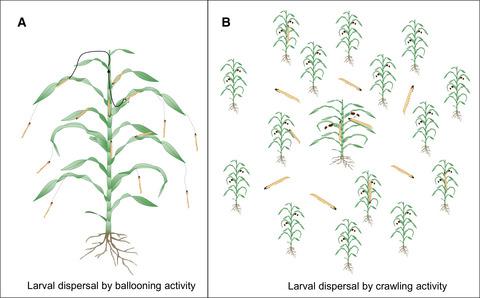当前位置:
X-MOL 学术
›
Entomol. Exp. Appl.
›
论文详情
Our official English website, www.x-mol.net, welcomes your feedback! (Note: you will need to create a separate account there.)
Larval dispersal of the invasive fall armyworm, Spodoptera frugiperda , the exotic stemborer Chilo partellus , and indigenous maize stemborers in Africa
Entomologia Experimentalis et Applicata ( IF 1.9 ) Pub Date : 2020-04-01 , DOI: 10.1111/eea.12899 Bonoukpoè M. Sokame 1, 2 , Sevgan Subramanian 1 , Dora C. Kilalo 2 , Gerald Juma 3 , Paul‐André Calatayud 1, 4
Entomologia Experimentalis et Applicata ( IF 1.9 ) Pub Date : 2020-04-01 , DOI: 10.1111/eea.12899 Bonoukpoè M. Sokame 1, 2 , Sevgan Subramanian 1 , Dora C. Kilalo 2 , Gerald Juma 3 , Paul‐André Calatayud 1, 4
Affiliation

|
Larval dispersal either through ballooning or crawling results in a redistribution of the insect population and infestations within and between plants. In addition, invasive species, such as the fall armyworm (FAW), Spodoptera frugiperda (JE Smith) (Lepidoptera: Noctuidae), and the exotic stemborer Chilo partellus (Swinhoe) (Lepidoptera: Crambidae), may displace indigenous stemborers on maize in Africa. To test whether larval dispersal activity may play a role in the displacement of indigenous stemborers, larval dispersal was compared between FAW, C. partellus, and the indigenous species Busseola fusca (Fuller) and Sesamia calamistis (Hampson) (both Lepidoptera: Noctuidae). Twenty potted maize plants were infested with one batch of eggs either from stemborers (B. fusca, S. calamistis, or C. partellus) or from FAW and monitored in the greenhouse for ballooning activities. After egg hatching, both ballooning and non‐ballooning larvae were identified according to species and counted. FAW neonate larvae had greater potential for ballooning off than stemborers, irrespective of species. For each species, more females dispersed than males, and their survival rate was higher than that of non‐ballooning larvae. In addition, plant‐to‐plant larval movements were studied using 6.25‐m2 plots of caged maize in a completely randomized design with five replicates. FAW was found to have wider dispersal and plant damage potential than any of the stemborer species. In conclusion, in contrast to C. partellus, the invasive characteristic of FAW can be explained, in part, by its higher larval dispersal activity compared to stemborers. This difference in larval dispersal might also be considered in sampling plans for monitoring pest density in the field.
中文翻译:

入侵秋粘虫、草地夜蛾、外来茎螟和非洲本土玉米螟的幼虫传播
幼虫通过膨胀或爬行传播导致昆虫种群的重新分布以及植物内部和植物之间的侵扰。此外,入侵物种,如秋粘虫(FAW)、草地贪夜蛾(JE Smith)(鳞翅目:夜蛾科)和外来茎螟(Swinhoe)(鳞翅目:蟹科),可能会取代非洲玉米上的本地螟虫. 为了测试幼虫传播活动是否可能在本地茎螟的迁移中发挥作用,比较了 FAW、C. partellus 和本地物种 Busseola fusca (Fuller) 和 Sesamia calamistis (Hampson)(鳞翅目:夜蛾科)之间的幼虫传播。用一批来自茎螟(B. fusca、S. calamistis 或 C. partellus)或来自一汽,并在温室中监测气球活动。卵孵化后,根据物种识别气球和非气球幼虫并进行计数。无论物种如何,一汽新生幼虫比茎螟有更大的膨胀潜力。对于每个物种,分散的雌性多于雄性,存活率高于非气球幼虫。此外,使用 6.25 平方米的笼养玉米地块以完全随机的设计进行了五次重复,研究了植物间幼虫的运动。发现秋粘虫比任何茎螟物种具有更广泛的传播和植物损害潜力。总之,与 C. partellus 相比,FAW 的侵入性特征可以部分解释为与茎螟相比具有更高的幼虫传播活性。
更新日期:2020-04-01
中文翻译:

入侵秋粘虫、草地夜蛾、外来茎螟和非洲本土玉米螟的幼虫传播
幼虫通过膨胀或爬行传播导致昆虫种群的重新分布以及植物内部和植物之间的侵扰。此外,入侵物种,如秋粘虫(FAW)、草地贪夜蛾(JE Smith)(鳞翅目:夜蛾科)和外来茎螟(Swinhoe)(鳞翅目:蟹科),可能会取代非洲玉米上的本地螟虫. 为了测试幼虫传播活动是否可能在本地茎螟的迁移中发挥作用,比较了 FAW、C. partellus 和本地物种 Busseola fusca (Fuller) 和 Sesamia calamistis (Hampson)(鳞翅目:夜蛾科)之间的幼虫传播。用一批来自茎螟(B. fusca、S. calamistis 或 C. partellus)或来自一汽,并在温室中监测气球活动。卵孵化后,根据物种识别气球和非气球幼虫并进行计数。无论物种如何,一汽新生幼虫比茎螟有更大的膨胀潜力。对于每个物种,分散的雌性多于雄性,存活率高于非气球幼虫。此外,使用 6.25 平方米的笼养玉米地块以完全随机的设计进行了五次重复,研究了植物间幼虫的运动。发现秋粘虫比任何茎螟物种具有更广泛的传播和植物损害潜力。总之,与 C. partellus 相比,FAW 的侵入性特征可以部分解释为与茎螟相比具有更高的幼虫传播活性。


























 京公网安备 11010802027423号
京公网安备 11010802027423号